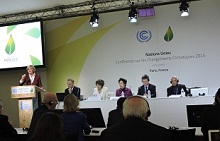
WHO side event at COP21 stressing the importance of integrating health into climate change agreements – Ramon Lorenzo Guinto
Paris – On 12 December 2015 at the UN Climate Change Conference of the Parties (COP21), leaders from around the world reached the first global agreement on climate change, moving towards a future for a healthier planet, and healthier people.
The agreement reflects an ambitious aspiration to keep global warming “well below” 2° C, and its explicit references to health represent a milestone in recognizing the health impacts of climate change. These include reference to the “right to health” in the preamble. The “co-benefits” of climate mitigation for “adaptation, health and sustainable development” are also recognized in the decision on “enhanced actions” to be taken prior to the year 2020.
“This agreement is a critical step forward for the health of people everywhere. The fact that health is explicitly recognized in the text reflects the growing recognition of the inextricable linkage between health and climate,” said Dr Maria Neira, WHO Director, Department of Public Health, Environmental and Social Determinants of Health. “Health is essential to planning and assessing effective climate adaptation and mitigation actions, and better health will be an outcome of effective policies,” Dr Maria Neira added.
The Paris Agreement incorporates health by also making reference to the original 1992 United Nations Framework Convention on Climate Change (UNFCCC), which referred to health as one of the adverse effects of climate change (Article 1), and to the commitments of countries to assess the health implications of adaptation and mitigation policies (Article 4). And it makes reference to the outcome of the 2010 UNFCCC conference in Cancun, which identified health as a priority in climate adaptation actions.
The Paris Agreement is framed by a bold ambition to keep warming “well below” the 2° C point regarded as untenably dangerous by scientists, and “pursuing efforts to limit the temperature increase to 1.5° C.” As per the demand of many less developed countries, it sets forth a framework for “differentiated responsibilities” for climate actions, recognizing that developed countries should take the lead in reducing greenhouse gas emissions, while also providing for actions by developing countries as well.
The agreement includes a strong commitment to climate adaptation actions, recognizing the principle of loss and damage due to climate change, and the protection of those most vulnerable. There also is provision for transparent monitoring and review and revision every five years – terms which had been promoted by both experts and civil society to track mitigation actions in reality and their impacts.
However, while providing a framework for actions, including strong actions by the health sector, the real outcome of the Paris conference will still depend on the actions taken by countries to interpret and implement the agreement in their own policies.
The text of the references to health include the following:
- In the PREAMBLE of the overarching “Paris Agreement” as well as in the “Decision” of the Parties to adopt the agreement: “Acknowledging that climate change is a common concern of humankind, Parties should, when taking action to address climate change, respect, promote and consider their respective obligations on human rights, the right to health, the rights of indigenous peoples, local communities, migrants, children, persons with disabilities and people in vulnerable situations and the right to development, as well as gender equality, empowerment of women and intergenerational equity.”
- ENHANCED ACTION PRIOR TO 2020: “Recognizes the social, economic and environmental value of voluntary mitigation actions and their co-benefits for adaptation, health and sustainable development.”
2015, WHO



